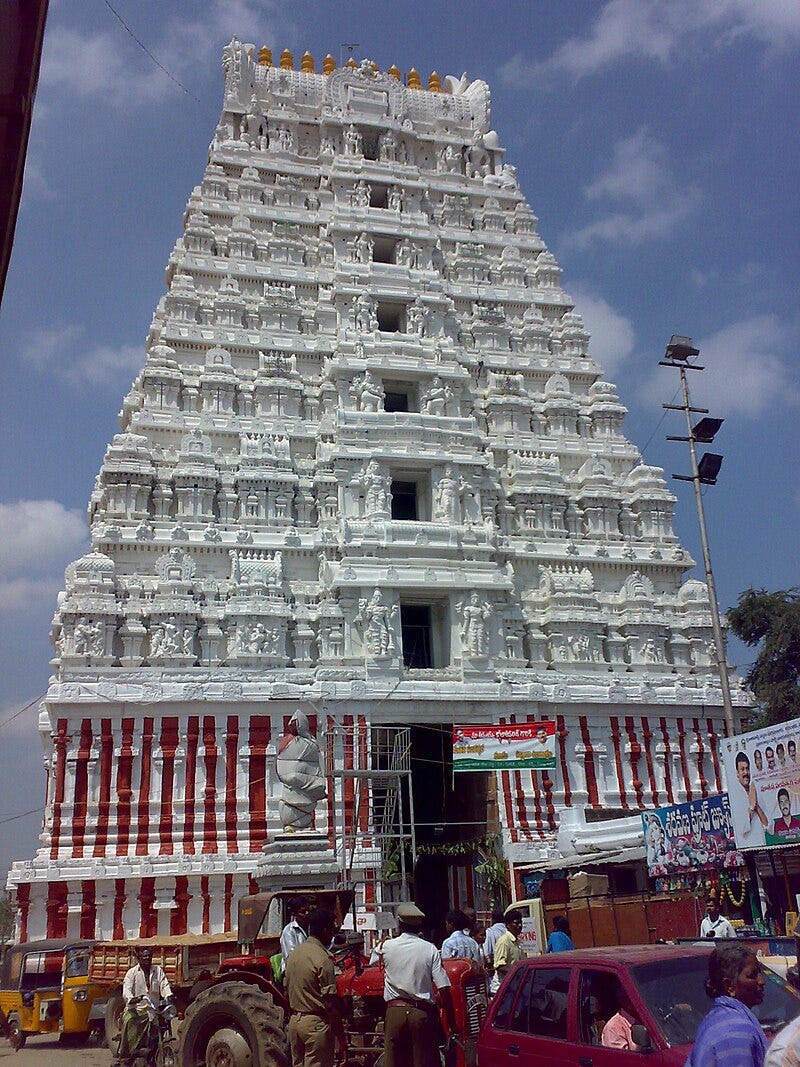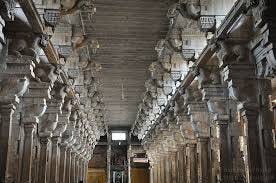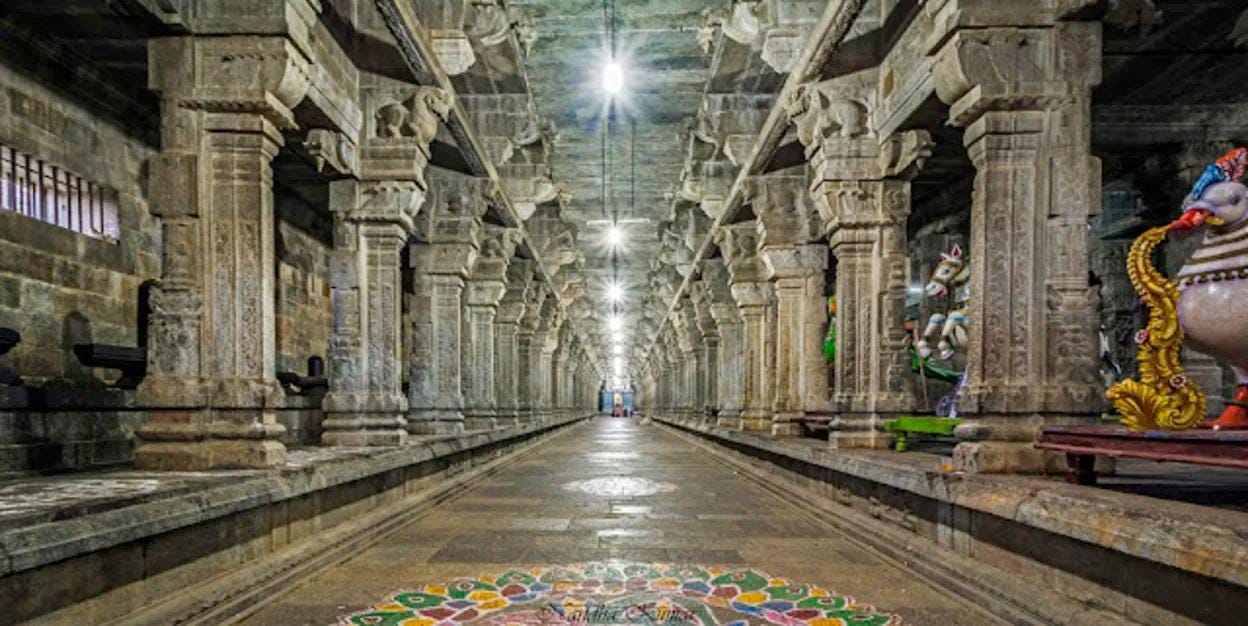One of the prominent Shaiva Kshetras in India, and also one of the Panchabhoota Lingams, where Shiva is represented here as Vayu( Air), and also known for the story of Kannappa Nayanar. The temple is regarded as Dakshina Kasi, as well as Rahu-Ketu Kshetram, and is located on the banks of the Swarnamukhi River.
As per the Sthala Purana, Vayu performed penance to the Karpoora Lingam and pleased with his devotion, Shiva offered him 3 boons, he would be present everywhere in the world, and also an integral part of all living beings. And the lingam worshipped by him would be known as Vayu Linga.
As per another story, once Parvati adamantly demanded Shiva to teach her the Panchakshari Mantra, and angry with her, he cursed her to be born as a human being on earth. Parvati performed penance to Shiva, and pleased with her devotion, granted her a form which was more divine than her earlier form, and taught her the sacred mantra. She is worshipped here as Gnana Prasunambika.
History
The temple was mentioned for the first time by a 3rd century Sangam era poet, Nakeeran, where he called it as Dakshina Kasi. Other Sangam era poets like Appar, Sambadar, Manikyavasagar also visited the temple.
One can find sculptures on the rocks around the temple dating to the Pallava era, who also built the ancient temple here. The Cholas under Rajendra Chola 1, renovated and built the main temple in 11th century AD here. The Dakshina Gali Gopuram was built by Kulotunga Chola 1, while Kulotunga Chola III, built the other temples in the complex.
The prakaram around the temple, and the 4 main gopurams were built during time of Viranarsimha Yaduvaraya in the 12th century. The great Vijayanagara Emperor Shri Krishnadevaraya, got the 100 pillar Mantapam with intricate carvings built around 1516, as well as the 120 feet main gopuram, towards the east, to symbolize his victory over the Gajapatis. This was the one that collapsed in 2010, and was again rebuilt and consecrated in 2017.
Architecture
This is one of the largest Shaiva temples in India, the devotees can see all the main gopurams from the shrine of Gnana Prasunambika. The temple is also known as Rahu Keta Kshetram, it’s believed that Vashishta Maharshi, suffering from the loss of his son, prayed to Shiva, who appeared before him as Panchamukhi Nagalingeswara. Since then Rahu Keta Puja is conducted here, to get rid of Sarpa Dosha.
One of the features of this temple is that Ganesha, Sri Kalahasteeswara, Gnana Prasunambika and Dakshinamurthy shrines are stragetically placed at each direction as the guardians. The Patala Ganapati temple is towards the North, Ammavaru’s temple is towards East, while Kalahasteeswara faces West, and Dakshinamurthy towads the South.
The Vayu Lingam here is made of white stone in a tall cylindrical shape, divided into 5 segments. Two lamps on either side keep continously flickering to indicate the presence of Vayu, while many other lamps her illuminate the Lingam.
There are 4 gopurams and the main 120 ft Raja Gopuram built by Shri Krishnadeva Raya. Also there is the Bhikshala Gopuram opposite the Theru Street, which forms the entrance to the temple, believed to be built by Devadasis, who worshipped Shiva as Jangama. The eastern gopuram is named after Bala Gnanambi, the northern one as Sivayya Gopuram, and the western one as Tirumanjana Gopuram, which is flanked by the Surya and Chandra Pushkarni. From the Southern gopuram, one can visit the shrine of Bhakta Kanappa and Brahma.
The Patala Ganapati shrine is located near the entrance, and only one can enter at a time descending a narrow fleet of stairs down 20 feet. There are also other Shiva Lingas believed to have been installed by Maharshis and Devatas, the Ardhanariswara Lingam by Bhrigu Maharshi, Neelakanteswara Lingam by Agastya Maharshi, Manikanteswara by Atreya Rishi and Mrityunjeswara Lingam by Rishi Markandeya. There are also Lingams believed to have been installed by Rama, Parashurama, Yama, Chitragupta and Yudhistir.
Kaalabhairava is the Kshetrapalaka, and there are shrines to Subramanya Swamy, Navagrahas, the 64 Nayanars, Venkateswara Swamy, Varadaraja Swamy within the complex. The temple has many mantapams with richly intricate carvings and frescos, that include Nagareswara Mantapam, Kota Mantapam. The coronation of Shri Krishnadeva Raya’s brother Achyuta Raya took place in the 16 pillared Mantapam in 1529.
The temple has one of the grandest Mahashivratri celebrations , where the deities of Sri Kalahasteeswara and Gnana Prasunambika are taken in a procession in the Mada streets around the temple mounted on Nandi. Lakhs of devotees attend the Brahmotsavams, from Telugu states, Tamil Nadu and Karnataka for those 3 days. Many folk artistes, singers, musicians, dancers attend and perform at these celebrations. Some well known artistes who performed here include actress, Bharatanatyam artiste Shobana, late SP Balasubramanyam, music director Manisharma.
Sri Kalahasti is located close to Tirupati, just an hour’s drive, the massive temple complex, the history and heritage is worth a visit.









